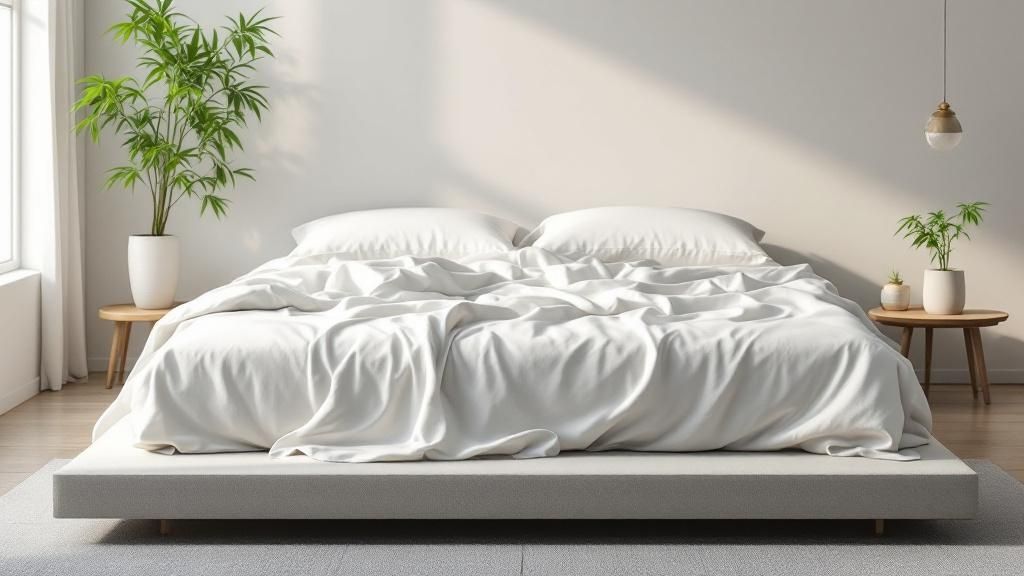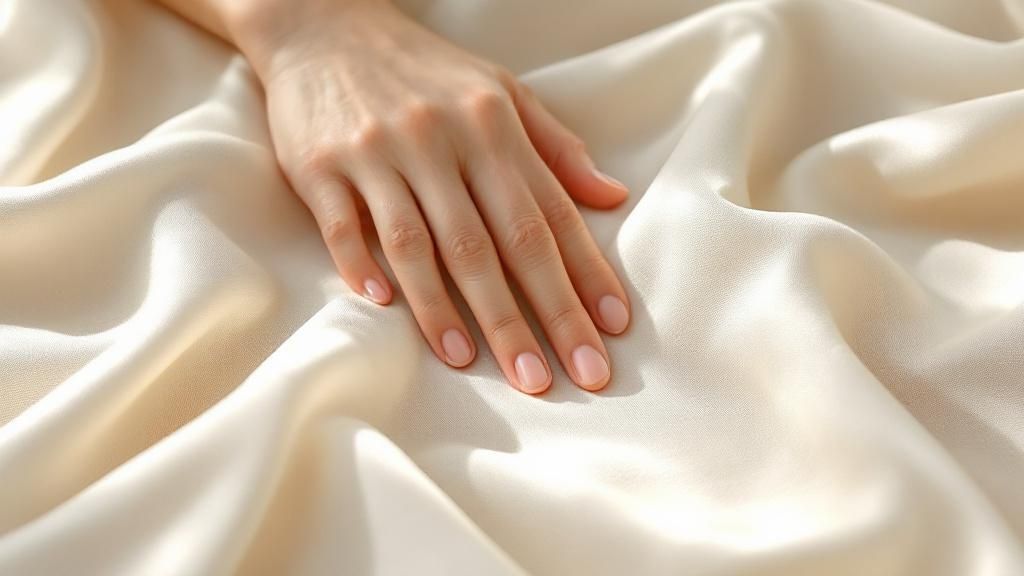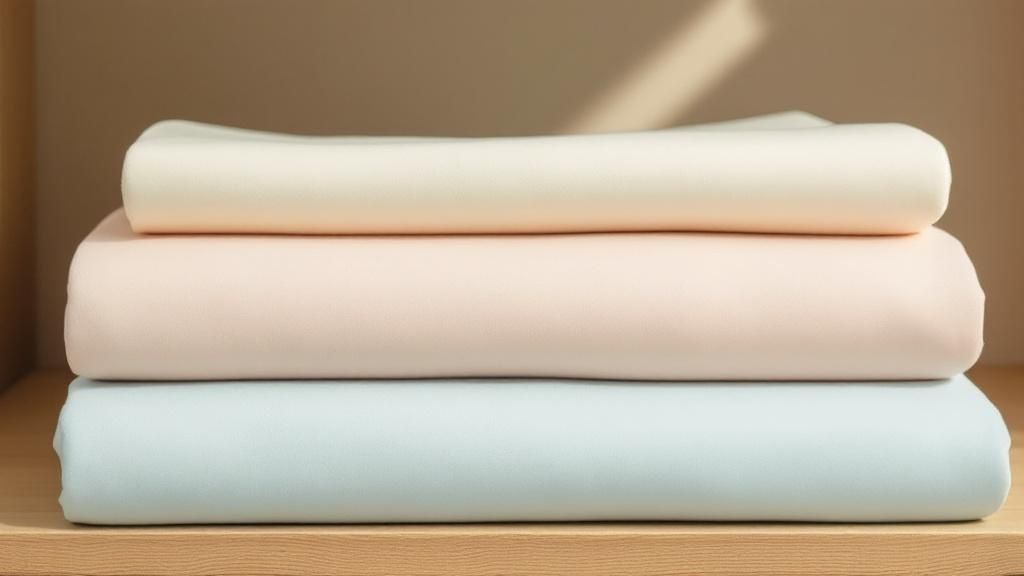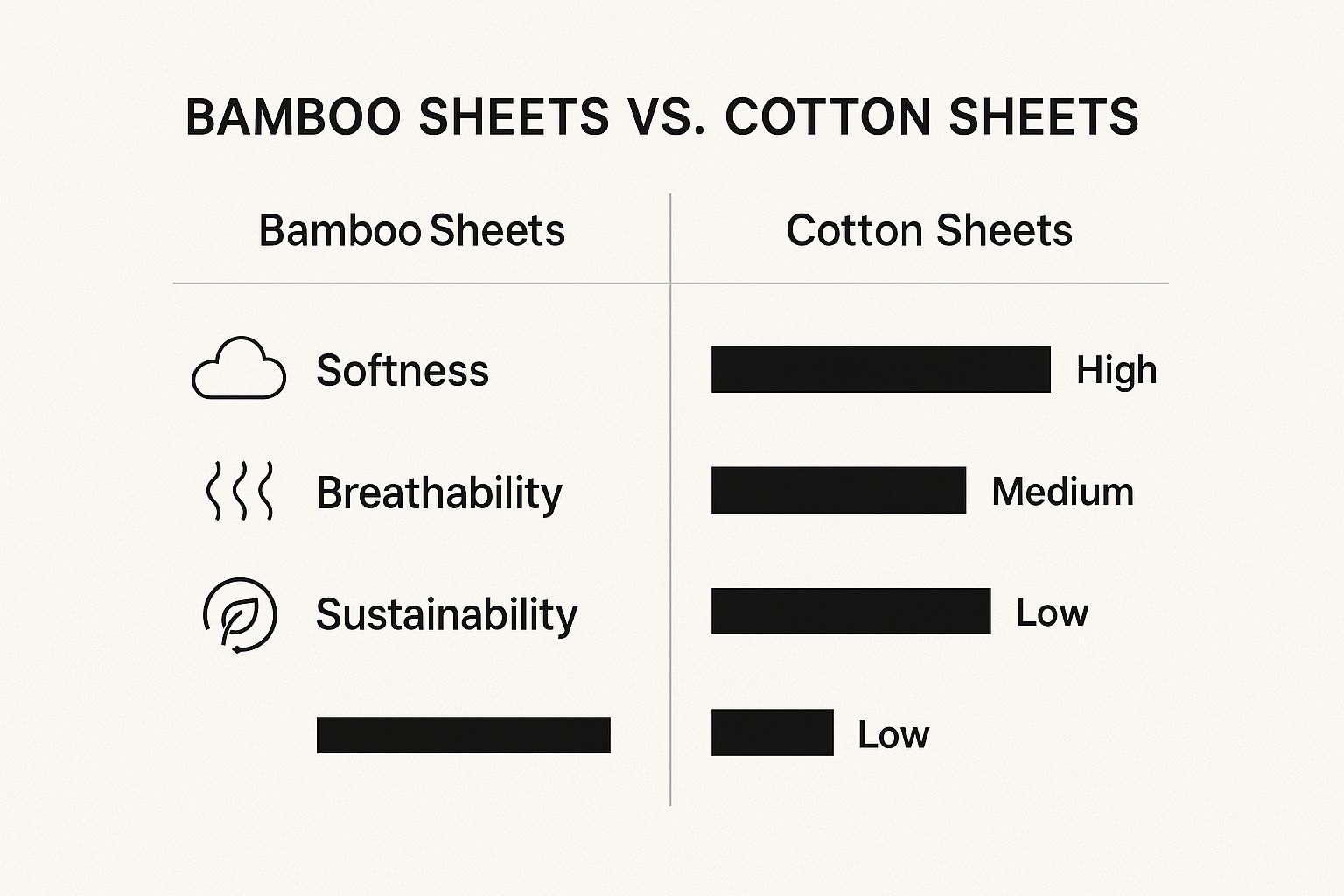So, what are bamboo sheets, really? In simple terms, they're textiles woven from the fibers of the bamboo plant. Think of them as a modern, almost silk-like alternative to the cotton sheets you're used to, but celebrated for a unique combination of softness and performance.
Getting to Know Bamboo Bedding
Bamboo sheets have absolutely exploded in popularity, and once you feel them, you understand why. They have a luxurious feel, are fantastic at regulating temperature, and resonate with anyone trying to make more eco-conscious choices. The plant’s fast-growing fibers are transformed into some of the most comfortable bedding you can find.
This rapid growth is a huge part of bamboo's story. The global bamboo market—which covers everything from flooring and furniture to these very sheets—was valued at roughly $67.4 billion and shows no signs of slowing down. This makes sense when you consider that some bamboo species can shoot up over 35 inches in a single day, making it an incredibly renewable resource. You can read more about this impressive growth on StraitsResearch.com.

Why Thread Count Isn't the Whole Story
With cotton, we're trained to look for high thread counts as a measure of quality. For bamboo, it's a bit different. The real magic comes from the inherent properties of the bamboo fiber itself.
- Silky Softness: People often compare the feel to high-end silk or the best Egyptian cotton. The texture is incredibly smooth and gentle, making it a dream for sensitive skin.
- Temperature Regulation: If you're a hot sleeper, this is a game-changer. The fabric is naturally breathable and wicks moisture away from your body, helping you stay cool and dry all night.
- Naturally Hypoallergenic: Bamboo has properties that help it resist dust mites and other common allergens. This is a huge plus for anyone with allergies or sensitivities.
These qualities are precisely why so many people are making the switch. In fact, you can find a deep dive into 20 reasons bamboo sheets are better that covers even more benefits.
To make it even clearer, here's a quick rundown of what makes these sheets so special.
Bamboo Sheets at a Glance
| Key Feature | Description |
|---|---|
| Exceptional Softness | A smooth, silky texture often likened to cashmere or silk. |
| Breathability | The fibers allow for excellent airflow, preventing overheating. |
| Moisture-Wicking | Pulls sweat away from the body, keeping you dry and comfortable. |
| Hypoallergenic | Naturally resists dust mites and mold, ideal for sensitive skin. |
| Durability | Strong, long fibers make for a durable fabric that holds up well to washing. |
| Eco-Friendly Source | Made from a fast-growing, renewable plant that requires minimal resources. |
Ultimately, the combination of luxury, comfort, and sustainability is what puts bamboo bedding in a class of its own.
Decoding the Different Types of Bamboo Fabric
When you pick up a set of sheets labeled "100% bamboo," you might think that tells you everything you need to know. But honestly, that’s just the beginning of the story. The real difference lies in how that tough, woody bamboo stalk gets turned into the soft, luxurious fabric you sleep on.
This manufacturing process is what truly defines the final product's feel, its price, and, importantly, its environmental footprint. Figuring out these distinctions is your best tool for choosing sheets that genuinely match what you care about most, whether that's unmatched softness, eco-friendliness, or staying on budget.
Bamboo Viscose: The Classic Softie
The most common type you'll find on the market is bamboo viscose, which you might also see labeled as bamboo rayon. This is the fabric that put bamboo sheets on the map. It's responsible for that buttery-soft, almost silky texture that people absolutely rave about.

But here’s the trade-off. To get that signature softness, the bamboo pulp has to go through a pretty intensive chemical process to break it down. This has definitely raised some valid environmental concerns over the years. That's why I always tell people to look for an OEKO-TEX certification. It’s your assurance that the finished sheets are tested and free from any harmful leftover chemicals.
So, while viscose absolutely delivers on that luxurious comfort, its production method is something to keep in mind if sustainability is high on your list.
Bamboo Lyocell: The Eco-Conscious Upgrade
For those looking for a greener option without sacrificing softness, bamboo lyocell is quickly becoming the new star. It's often praised for its much more sustainable manufacturing process.
Lyocell is made using a non-toxic solvent in what’s known as a "closed-loop" system. This is a game-changer because it means over 99% of the solvent and water are captured and reused in the next batch instead of being released as waste. It’s a brilliant way to drastically cut down on pollution.
Sheets made from bamboo lyocell have that same incredible softness and breathability as their viscose cousins, but they come with a much lighter environmental conscience. As you might expect, this more advanced and responsible process usually means a higher price.
It really boils down to your personal priorities. Viscose gives you that incredible softness at a more wallet-friendly price, while lyocell offers a similar luxury feel with the peace of mind that comes from a more sustainable production cycle.
You might also stumble across a couple of other, less common types:
- Bamboo Modal: Think of it as viscose’s cousin—but even softer and stronger. It's known for having a beautiful drape and is great at resisting those annoying little pills that can form over time.
- Bamboo Linen: This one is entirely different. It’s made using a mechanical process of crushing bamboo fibers, resulting in a more rustic, textured fabric. It’s super durable and breathable but doesn't have that silky smoothness you get from viscose or lyocell.
At the end of the day, knowing what’s actually behind the label is what empowers you to make a smart choice and find the perfect bamboo sheets for your bed.
The Real-World Benefits of Sleeping on Bamboo
So, what's the actual difference when you sleep on bamboo sheets? Let's get past the marketing claims and talk about what you'll really notice, often from the very first night. The most immediate thing people comment on is the incredible softness. It’s a feeling often compared to high-end silk or even cashmere, creating a truly luxurious sensation against your skin.
That initial comfort is what gets people hooked, but the real game-changer for many—especially those of us who run hot at night—is the fabric's natural ability to regulate temperature.

The secret is in the unique fiber structure, which is exceptionally breathable and fantastic at wicking moisture away from your body. Instead of trapping heat and sweat like some other materials do, bamboo helps it evaporate. The result? You stay comfortably cool and dry all night long. If you're someone who constantly kicks off the covers, this one feature can make a world of difference to your sleep quality. You can dive deeper into why bamboo sheets are a cool and eco-friendly choice for hot sleepers in our other guide.
A Gentle Choice for Sensitive Skin
Another huge advantage comes from bamboo's inherent properties, which are a true blessing for anyone with sensitive skin or allergies. The fabric is naturally hypoallergenic and antibacterial, meaning it helps keep common irritants at bay.
Here’s what that looks like in the real world:
- Fewer Allergens: The fabric’s weave naturally resists dust mites and mold—two of the most common culprits for nighttime allergies and stuffiness.
- Less Irritation: Bamboo fibers are smooth and round, so they create far less friction against the skin than coarser fabrics like certain cottons. This can be a huge relief for conditions like eczema.
- Stays Fresher, Longer: Bamboo fabric doesn't readily absorb skin oils, which prevents the yellowing and bacterial buildup that can happen over time with other sheets.
It's these practical benefits that are fueling some serious growth in the industry. The bamboo textile market, currently valued at around $500 million, is expected to grow by about 7% each year through 2033. This boom is driven by people seeking that perfect mix of softness, breathability, and antimicrobial qualities. For more on this trend, check out the data from Archive Market Research.
When you add it all up—the luxurious comfort, the impressive performance, and the gentle touch—it makes a pretty compelling case for making the switch to bamboo bedding.
How to Choose the Right Bamboo Sheets for You
Ready to make the switch to bamboo sheets? It's a great move, but shopping for them isn't quite like buying traditional cotton. The first thing you need to do is forget everything you know about thread count. Seriously. For cotton, a high thread count often means luxury, but with bamboo, it's a different story.
With bamboo fabric, chasing a high thread count can be a mistake. The sweet spot is actually a much lower 300-400 thread count. This range gives you that signature silky softness and incredible breathability bamboo is famous for. If you go much higher, the weave can become too dense, trapping heat and defeating one of the best reasons to own them in the first place.
Decoding the Label Like an Expert
To find a truly fantastic set of bamboo sheets, you need to look past the marketing fluff and focus on the details that really matter. The information on the label tells you everything about how the sheets will feel, perform, and hold up over time.
Here are the three most important things to check on the packaging before you buy:
- Fabric Type: Look for 100% bamboo viscose or 100% bamboo lyocell. Viscose is the most common and delivers that buttery-soft feel. Lyocell feels very similar but is made using a more environmentally friendly closed-loop process.
- Weave Style: You'll usually see two options: sateen or twill. A sateen weave creates a shinier, silk-like finish that glides over your skin. If you prefer something a bit more durable with a little more texture, a twill weave is a fantastic choice—it feels substantial without being slippery.
- Certifications: This one is non-negotiable. Always look for the OEKO-TEX Standard 100 certification. This is an independent verification that guarantees the fabric is completely free from harmful chemicals and substances, making it safe for even the most sensitive skin.
To see how bamboo stacks up against other popular materials, I've put together a quick comparison table. It's a simple way to see the pros and cons at a glance.
Bamboo vs Cotton vs Microfiber Head-to-Head
| Feature | Bamboo Sheets | Cotton Sheets | Microfiber Sheets |
|---|---|---|---|
| Softness | Exceptionally soft, silky, and smooth | Softness varies by type (Pima, Egyptian) | Can feel soft but is synthetic |
| Breathability | Highly breathable and moisture-wicking | Good breathability, but can retain moisture | Tends to trap heat; not very breathable |
| Durability | Very durable if cared for properly | Generally very durable, especially long-staple | Durable but prone to pilling over time |
| Eco-Friendliness | Highly sustainable and renewable resource | Varies; organic is better but uses lots of water | Petroleum-based; not biodegradable |
| Hypoallergenic | Naturally hypoallergenic and antibacterial | Can be hypoallergenic, but less so than bamboo | Yes, but can trap allergens like dust |
| Cost | Mid-to-high price range | Wide price range, from budget to luxury | Typically the most affordable option |
As you can see, while cotton is a classic and microfiber is a budget-friendly choice, bamboo really shines when it comes to combining luxurious softness with practical performance benefits like breathability and sustainability.

My Pro Tip: Be wary of blends. You'll often see sheets labeled "bamboo blend," which usually means they've been mixed with microfiber or cotton. To get the full, unadulterated benefits—that amazing softness and top-tier temperature regulation—stick with sheets that are "100% Bamboo Viscose" or "100% Bamboo Lyocell."
By focusing on the fabric type, weave, and safety certifications instead of getting hung up on thread count, you're setting yourself up for success. It's the best way to ensure you bring home a high-quality set of sheets that you'll look forward to sleeping on for years to come.
Keeping Your Bamboo Sheets Feeling Like New
You’ve brought home that incredible, buttery-soft feeling of new bamboo sheets. Now, let's talk about how to keep them that way. With just a little bit of mindful care, you can protect your investment and enjoy that same luxurious feel for years to come.
The secret really comes down to being gentle. Think of bamboo fabric as a high-quality natural fiber, because that's exactly what it is. It needs a delicate touch to preserve its integrity.
The Right Way to Wash and Dry
Always, and I mean always, wash your bamboo sheets in cold water. I recommend a maximum temperature of 30°C (that’s 86°F) on your machine's gentlest cycle. This simple step is the single most important thing you can do to prevent the fine fibers from getting damaged. Pair that with a mild, liquid detergent, and you're on the right track.
What you don't use is just as important. Fabric softeners and bleach are absolute no-gos. They're the quickest way to ruin the very things you love about your sheets.
- Avoid Fabric Softener: It leaves a residue that clogs the fabric's pores, which is what makes your sheets less breathable and moisture-wicking over time.
- Say No to Bleach: Harsh chemicals and aggressive stain removers will weaken the bamboo fibers, leading to thinning and even discoloration.
- Give Them Their Own Space: Wash your sheets by themselves. Tossing them in with towels or clothes with zippers is just asking for snags and pilling.
It helps to think of them like other high-end fabrics. In fact, many expert tips for caring for delicate garments, such as using cold water and avoiding high heat, are just as relevant for bamboo.
When it's time to dry, you've got a couple of solid choices. My personal preference is line drying them outside in the shade—it’s the kindest method and leaves them smelling amazing. If you need to use a machine, just be sure to tumble dry on the lowest heat setting possible. Pull them out as soon as they're done to keep wrinkles from setting in.
For a deeper dive into stain removal and other tips, head over to our complete guide on how to care for your bamboo sheets.
Your Top Bamboo Sheet Questions, Answered
Once you’ve got the basics down, a few practical questions always come up. I get these all the time from people trying to decide if bamboo sheets are right for them. Let’s get you some straight, honest answers so you can feel good about your choice.
Are Bamboo Sheets Actually Eco-Friendly?
This is a great question, and the answer isn't a simple yes or no. The bamboo plant itself is a champion of sustainability—it shoots up incredibly fast, doesn't need much water, and thrives without pesticides. But the "eco-friendly" part really comes down to how it's turned into fabric.
Most bamboo sheets on the market are bamboo viscose, which involves a chemical-heavy process that can be pretty rough on the environment. If you want a genuinely greener option, look for sheets made from bamboo lyocell. This process uses a non-toxic solvent in a closed-loop system, which means over 99% of the water and materials get recycled. Always check for certifications like OEKO-TEX and FSC to verify you're getting a more responsibly made product.
Will My Bamboo Sheets Wrinkle a Lot?
Honestly, yes, they tend to wrinkle. It’s a lot like what you see with high-quality cotton or linen sheets. This isn't a flaw; it's a natural trait of the long, smooth fibers. I like to think of it as a sign of authenticity—proof you've got the real thing.
To keep wrinkles at bay, I’ve found the best trick is to pull them from the dryer when they're still just a little damp. If you put them straight on your bed, you can smooth them out perfectly. Folding them right away helps, too. Also, make sure you're using a low-heat setting on your dryer—that makes a huge difference.
When it comes down to it, if you’re looking for incredible softness, fantastic temperature control for a better night's sleep, and hypoallergenic comfort, the investment in a quality set of bamboo sheets pays for itself over and over again.
Are Bamboo Sheets Really Worth the Money?
For most people I talk to, the answer is a big yes. The upfront cost is definitely higher than your standard cotton or microfiber sheets, but you’re not just paying for fabric—you're investing in a unique combination of benefits.
Here’s the value you're really getting:
- Next-Level Softness: A silky, smooth feel that truly competes with the most expensive fabrics out there.
- Incredible Temperature Control: A game-changer for hot sleepers. They wick moisture away and help keep you cool all night.
- Hypoallergenic Properties: They are incredibly gentle on sensitive skin and naturally resist common allergens.
Should I Stress About Thread Count?
Not really. Thread count is a much bigger deal when you're shopping for cotton. Because bamboo fibers are so long and fine, a lower thread count of 250-400 can feel far more luxurious and breathable than a 1000-thread-count cotton set.
My advice? Stop focusing on that number. For bamboo, what truly matters is the fabric type (lyocell is a premium pick) and the weave. A sateen weave will give you that silky feel, while twill offers a bit more durability.
Ready to experience the best sleep of your life? Bamtek offers 100% organic bamboo viscose sheets that are OEKO-TEX certified, incredibly soft, and perfect for regulating temperature. Discover the difference at bamtekhome.com.










